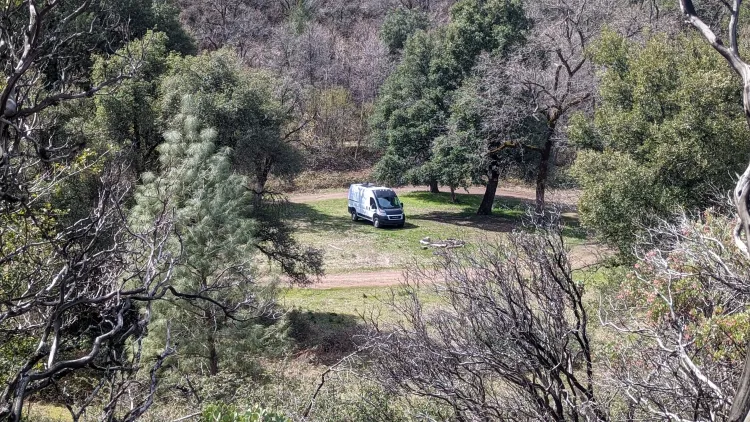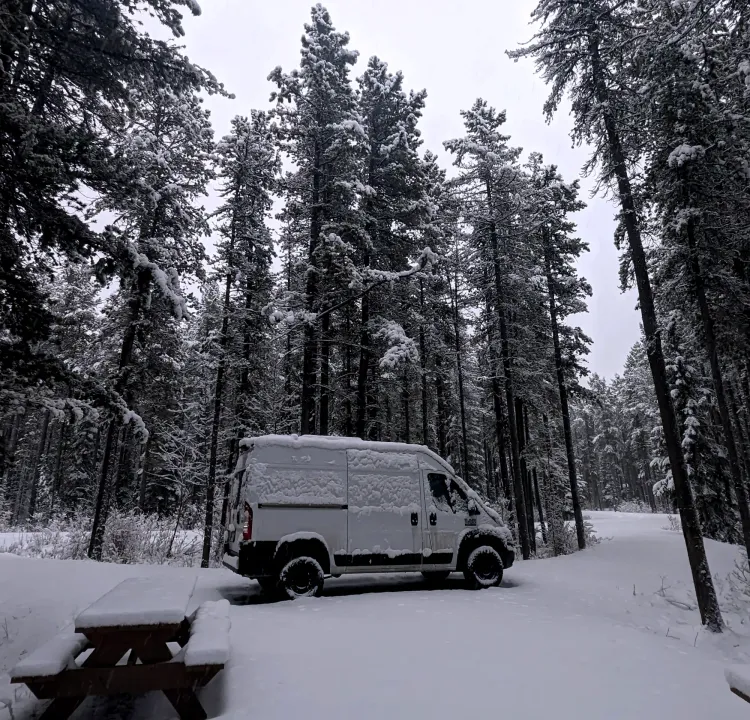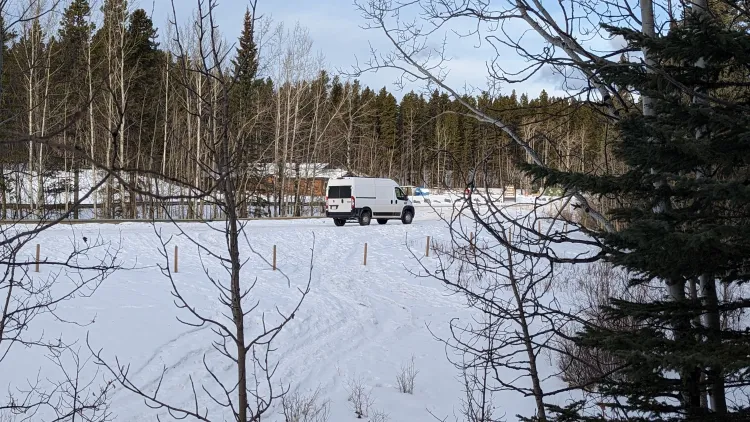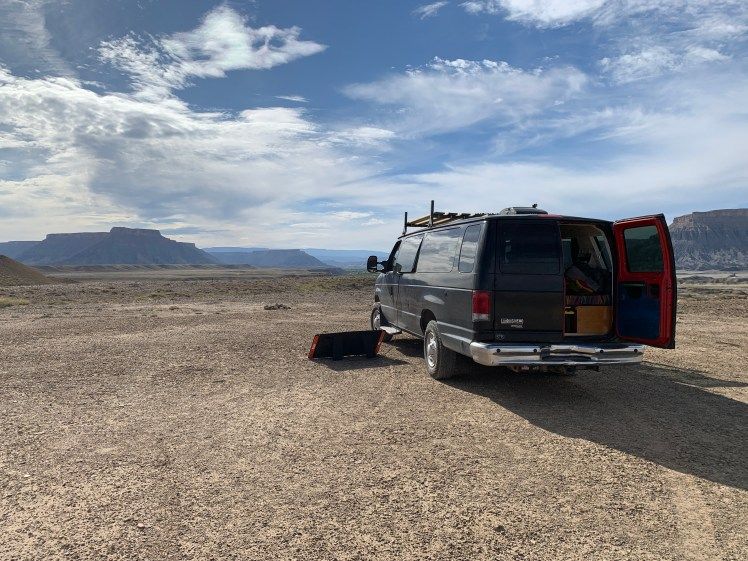How To Cook In A Van

We all need food. For some, food is life. Cooking at home is easy when we have access to unlimited power, space, tools, and many food options. Cooking in a van might be a bit harder, but it can still be a fun experience with the right knowledge.
Cooking in a van is similar to cooking at home, with some added difficulty. With the right tools, techniques, and preparation, cooking in your home on wheels can be just as fun!
Just starting out and want a bit more information before diving in? Check out Van Life - The Definitive Guide for answers to all of your questions!

Table of Contents:
Tools
I’ve enjoyed a few cooking shows in my time. They’ve shown me how fun cooking can be (and how many skills I don't possess), and many different ways to get the job done. I like to be explorative in how I cook things, even if I think I'll fail a dish. Let's start at the most basic, and go up to more advanced tools to get the job done. For the purposes of this section, tools refer to the medium we use to heat food.
No cook meals
This is a no-tool solution to food on the road. Perhaps the easiest, and even sometimes my go-to. This solution allows you to not need fuel or power to cook, and potentially fewer dishes are involved too! These meals can include pre-made salads, things like cereal and milk, yogurt, fruit and vegetables, cured meats, sandwiches, etc. My go-to no-cook meal is yogurt and granola with seeds and dried fruit like cranberries. I eat it nearly every day for lunch and have yet to get tired of it. (Right now I'm using shelf-stable yogurt as my electrical system was on the fritz and I wasn't confident in running my fridge off of my battery for some time.)

Open fire
Let's go back to our roots of primal living and camping. Using this can allow you to cook so many different foods like meat and vegetables (and S'mores for dessert). Using direct heat from a fire is a nostalgic and rustic way to cook food. Sometimes wieners over a fire are exactly what you crave. Having a portable grill to lay over the hot coals can create some phenomenal dishes. My go-to dishes include kebabs and sausages. The benefit of cooking this way is that any mess created can often be dealt with by the fire. There are often few dishes made this way, and fewer ingredients to get the job done. Unfortunately, this tool can't always be relied upon due to a lack of fuel (wood), restrictions, stealth factors, etc.
BBQ
This might be a luxury, but it’s something easily attained and accessible to most. Vegetables, meat, and so much more can be cooked this way. The source of heat can come from propane or even charcoal bricks. There are many different types of units to cook this way like smokers, and even some that have a pot attachment to boil water. When I use a BBQ, my favourite things to cook are steak, with mushrooms and onions as a side.
Camp Stove

My second most used cooking tool is a camp stove. These work really well in my setup since I don't use them for every meal. They're often highly portable, storable, and are often cheap. For the most part, there are two types. You have the portable backpacking variant (which can be used for more than backpacking) like Jetboils and Pocket Rockets, and the more traditional ones like the Coleman or GSI variant. They can run on a plethora of fuel types like butane, propane and even white gas.
The small variants are great when all you need is hot water. They boil water quickly with little setup. I use one almost every day for coffee. I also use it when I need hot water for things like ramen or soup.

The larger variants are incredibly handy when you need to cook something for longer. They can often be used with traditional pots and pans. The heat can be adjusted too. I like to use this when I bust out my cast iron pan to cook things like eggs, meat, and vegetables. I also use these when I need to cook things like pasta and rice since they often require heat for a bit longer than the backpacking variant.
RV stovetop/ Induction cooktops.
At this level, we're creeping up on luxury cooking tools. Not every rig will have the space/ infrastructure to support these items. When you use these types of items, cooking becomes very similar to in an actual kitchen. The benefit of these types of cook surfaces is that the heat can be fine-tuned, much like at home. Thus giving you more control over the heat source compared to the above-listed items.
RV Oven
The next level of luxury on the road. When you use ovens, you open up so many more options for the type of meals you can cook. Baked goods like muffins and bread and pies, as well as meat roasts, broiled mac and cheese, and even turkeys, can be cooked like this. Unfortunately, the downside to this is how many resources they use like power, fuel, money, and space.
Instapot/ crockpot/ air fryer
Now we have typical home tools that can be powered on the road. Croc pots are great for slow-cooked meals like chilli, pulled pork, stews, etc. Instapots are one of the most popular kitchen tools of the last few years. Not only can you air fry in some of them, but you can make pizzas. It is also possible to power these things without an obscene draw of power. Take a look at how this person uses an air fryer to make delicious meals!
Techniques
When cooking at home, we often take for granted all the techniques we use to create our meals. Things like ventilation for those smoky meals, running water, and often unlimited hard wear make cooking a breeze at home! While it's hard to replicate a full kitchen inside a van, we can come really close. Take a look at this video to see just how cooking-focused van builds can be.
Ventilation
Ventilation is critical for not sleeping in a garlic and olive oil-scented bed. It’s also important for ensuring you don't have a condensation build-up in your home. No one likes waking up to drops of water on their face.
Since van living involves a small shared space, moisture, scents and airborne food particles will get everywhere. This problem can largely be avoided by cooking outside, but if that's not possible, you will need a fan to exhaust the scented air, and preferably a second fan to create a cross breeze, or at the very least a window/ door opened to accomplish the same thing.
Condensation is another large issue when cooking in a van or small space. Not only do you create condensation from breathing, and the physics of a warmer space on the other side of a cooler space, but you also have the added moisture in the air from cooking. This issue is perhaps one of the largest battles we face as van lifers. Ensuring proper ventilation can alleviate a lot of these issues. While not directly related, I've run into issues storing Thermarest z fold pads under my mattress, to find out the dimples in them created moisture pockets that caused some mould build up on the mattress cover.

Cooking outside
A lot of the tools mentioned before would create a catastrophe if done indoors. The best solution to keeping your home space clean and tidy is to not do anything that would make it messy. Cooking outside can be fun, and a lot cleaner than doing it right next to your bed.
Typical van load-out packing lists often include bringing along a table to be used outdoors. Even routine things like boiling some water can be done outdoors to save on potential mess and moisture build-up. Certain foods can leave your bedding smelling like a plate of food too, so ensuring you cook outdoors can alleviate those issues.
Water
Water is a premium on the road. While we pay for it even at home, it needs to be rationed while living in a van. We tend to waste a lot of water when cooking in a traditional kitchen from things like rinsing foods, washing dishes, and straining things like pasta. Cooking meals that waste less water is a great way to conserve it, and cleaning with a minimal amount is great for the environment and your own pockets. I chose to add a foot pump for my water source since it was cheap, more robust and less power intensive than an electric variant, and it helps conserve water.
Refrigeration
Keeping things cold is important when you want fresh ingredients and not the dried/ canned variant. There are many types of fridges available, and many ways to keep things chilled while living in your van. Planning your meals can help with understanding how much fridge/ cooler space you'll need. We don't normally have as much fridge space on the road as we do at home. Space is a premium, so try and limit your items that need to be refrigerated. Even things like milk can be purchased in shelf-stable variants.
For me, I'll plan a few simple meals and collect all the ingredients for those recipes for a week at a time. Anything more and I find the fridge often isn't friendly to the fresh ingredients. When I go with my normal no-cook yogurt and granola, I usually buy the most economical type of yogurt and that is a staple in my fridge. I also enjoy keeping chilled water in there through a mix of two rotating Nalgene bottles.
Hardwear
Van cooking might mean reusing a lot of your tools as you likely don’t have multiple sets of measuring spoons, tongs, or even cutting boards on the road. Having small items is also something you might need to do while cooking on the road. This also might mean making multiple uses out of one item. It will involve cleaning as you go if you used a measuring cup for milk, and then need it for measuring broth.
When I was transitioning to van life, I started thinning out my possessions well before my departure date. This allowed me to start practicing with fewer kitchen tools and hone my skills with what I had. It also showed me the flaws in my process and allowed me to adjust and prepare for cooking on the road.

Preparation
Preparation is synonymous with planning. Planning is the key to success. Things like prepping all ingredients before cooking and strategically buying certain foods can make an impact on how easily you can cook in a van.
Prepare as much as possible before cooking
Doing everything ahead of time really helps with making the process go smoothly. It might end poorly if you need to add another step in the middle of cooking something and it's time-sensitive. Taking tips on how recipes are designed can help when making your own recipes.
In such a small space, you might be in the middle of a cook to realize you haven’t yet washed and cut your vegetable that needs to go in. So, you turn off your stove, move it aside and have to prep another ingredient.
Many recipes and instructions call for getting things ready in batches. Things like getting the dry ingredients prepared and combined, and the wet ones too. Get ingredients like spice ready to go and measured out before they need to be added.
In my experience, I've noticed that when I need to do something like cut garlic if I forgot to do it before, I throw off the rest of my meal. I like to think I've become familiar with my stove and cast iron pan. So, when I need to take my attention away from watching the heat, things don't go as smoothly as possible.
Buy pre-cut ingredients
A hack for the issue above is to buy as much pre-cut or prepared as possible. Doing this can save time, effort, cleaning, and even waste.
Of course, this solution doesn't always work. Convenient things are often a bit more expensive because of it. Sometimes, it's worth the effort to buy a clove of garlic instead of the pre-cut version. Even if you might need to waste some due to not being able to use it all.
When you chose to buy prepared ingredients, it saves a lot of resources. You don't need to pick the nicest and ripest one at the store. You don't use time processing it according to your recipe. Also, it helps with cleaning as you might not even need to bust out the cutting board.
Use the dry variant
While this should never be considered the same, or even better, sometimes getting the granulated version of onion/ garlic powder can help with the process of creating culinary delights in your mobile home. It saves on space too!
When I was preparing to head out on the road, I noted which ingredient I used the most. Garlic, Onion, Italian, etc. I always carry a powdered version of these as they make the basics of a quick dish. This matters, especially when you're in the middle of a travel day and don't necessarily want to take the time to process the ingredients of a dish.
Conclusion
Cooking in a van can be a lot of fun. It's rewarding to make delicious dishes in your home on wheels. The tools you use to cook with are plenty and can really impact how your dish turns out. Certain techniques and van cooking-specific ideas help with being able to cook effectively. Like most things, preparation makes this a lot easier. After reading this, I'm sure you'll come away with more knowledge of what it takes to create great meals in your van.







Member discussion